
The Professor Makes a Blunder
Creative non-fiction
copyright 2003
Motoring Investments HOME
THIS STORY IS ABOUT A 1971 TANGERINE SPORTOMATIC 911 THAT SOLD IN 2003
The other day I saw an ad in the paper for an early Porsche 911. They were selling Grandpa's car. I made the call and asked the usual questions about rust etc. The seller said it hadn't run since 1986 and had been sitting in garage ever since and was rust free. I jumped into the car with map in hand and made like a projectile toward a target. As I pulled up to the curb I noticed several other people walking from cars to the address I had written down. There was a middle aged guy who had gotten out of a late model Porsche and two younger guys who had driven up in some non-descript Asian car. As I walked up to the group it appeared that the Porsche driver was the high bidder. The seller was breaking the news to the young guys. I said, "wait a minute, what if it's worth more?". "Go ahead and look at it," said the seller. "I guess we should wait a bit anyway for this "Brian" who said he was coming." I didn't tell them right away that I was "the Brian".
I hit the floor with three competitors breathing down my neck. Front suspension pan, check. Jack ports, check. Passenger side lower corner of the windshield frame, check. Engine cover hinge area under the rear window, check. He's right. There is no rust on this car. So I tell him I'm Brian. "What do you think," says the seller. To make a long story short, I buy the car for $600 over the asking price.
I pay for the car and call for a flat-bed. Back at my shop my technician puts the car up on the lift and points out this rather obvious rust hole to me. Shoot, I didn't crawl waaaay under and poke around on the floor pan. I got in a hurry and figured if the most susceptible places were solid the pan would be also. So, why would just the pan rust in one spot? One word. SUNROOF. Of course, this is a sunroof coupe. Someone left the sunroof open in the rain once or twice. The rain pools at the lowest spot and is held there by the sound deadening mat......for months! Well, I should have been more cautious. Now, what to do? Make it right of course.
The hole.

The bad spot is cut out back to solid metal. The tab
pointing downward is a locating reference point.
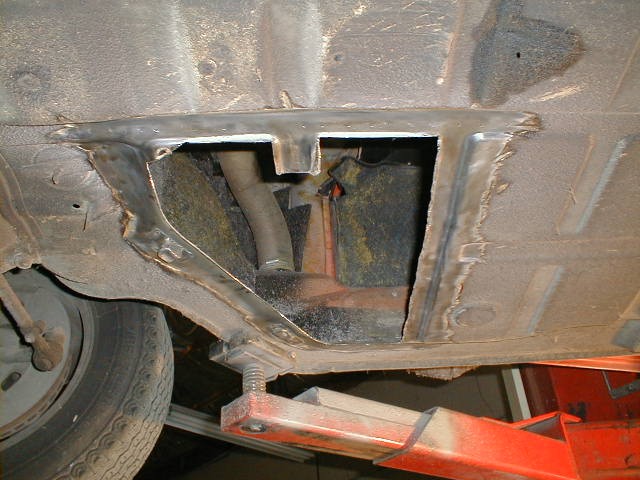
The new panel is carefully positioned.
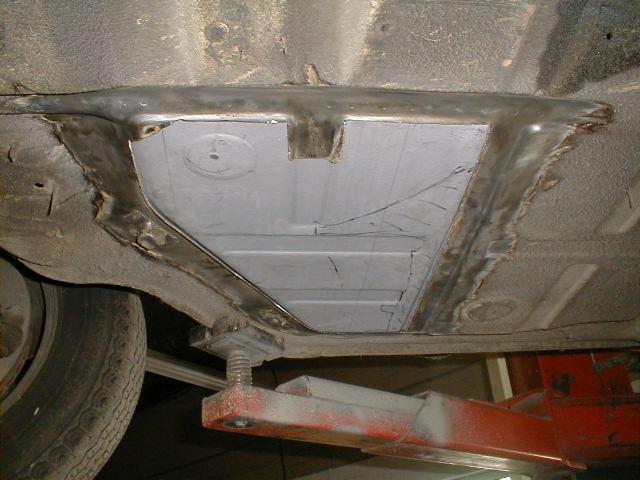
The new panel is cut to precisely fit the opening and is tacked
in place.
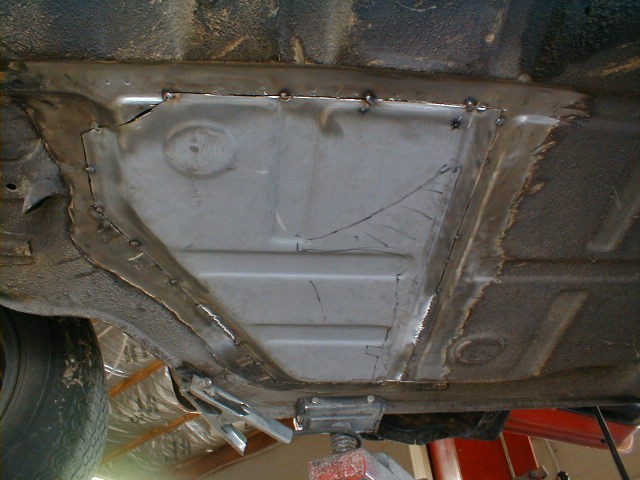
A continuous bead welds out the panels edge to edge.
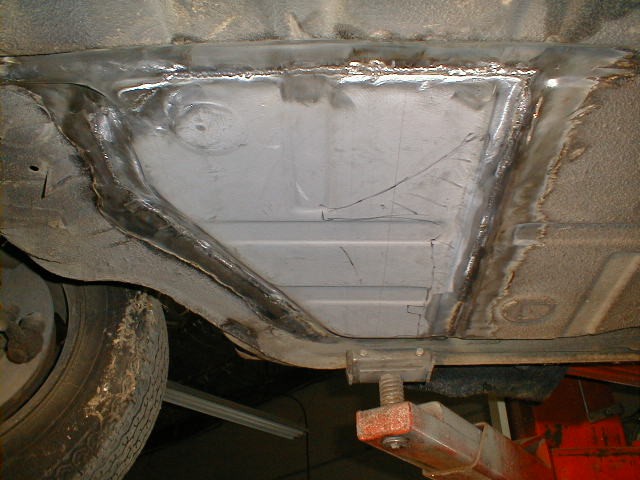
After the bead is ground flush we prime and apply the factory
undercoat to make a nearly invisible repair.
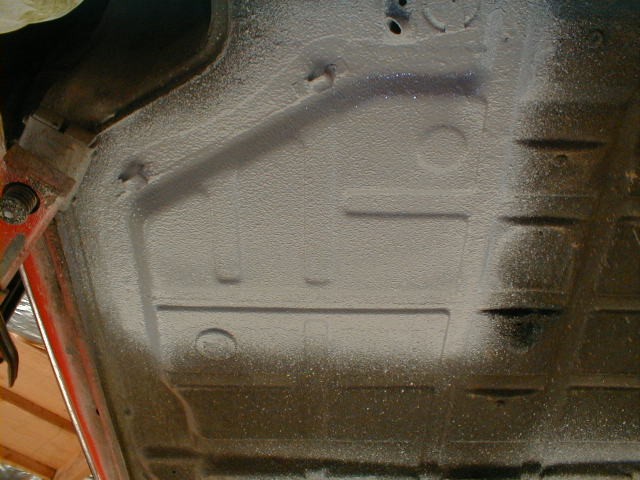
The inside shots.
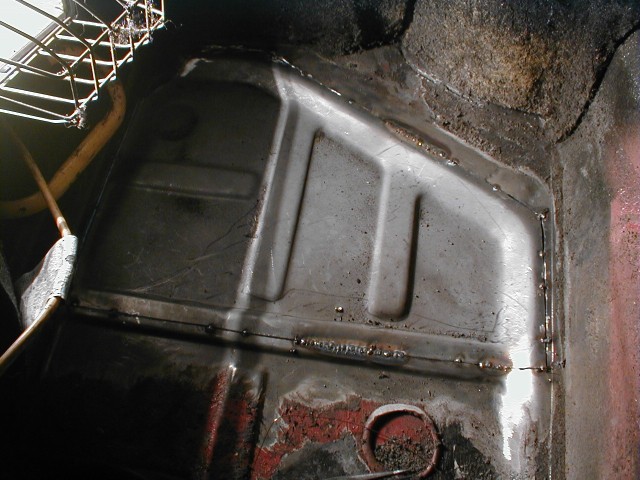
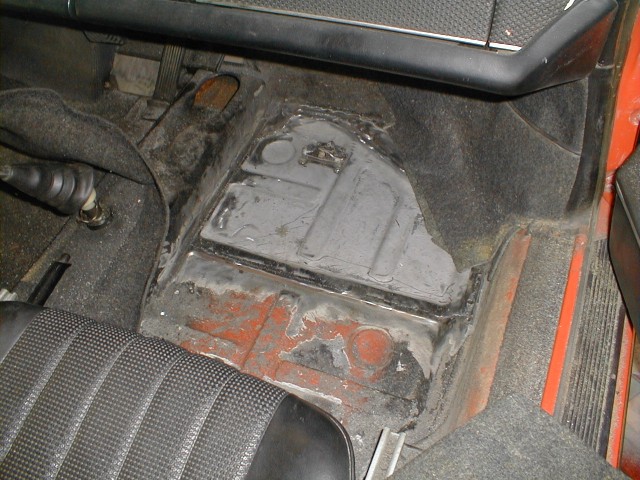
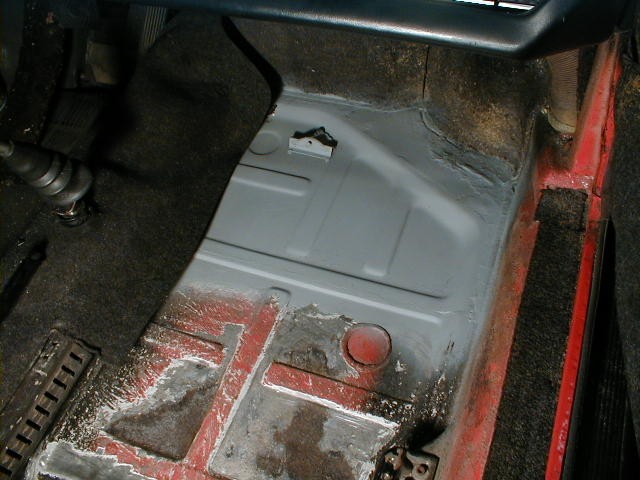
OK, great. High fives all around. This is a great repair. We put the car up on the lift once more and get ready for the final photos. I notice two tiny reddish spots on the rear floor pan. I push on one with an index finger and hear a sickening crunch as the floor board moves upward. Two more spots of rust.
The following is basically the same routine with a bit more detail.
Driver side

As automotive archeologists, once we dig down through the seat,
carpet, sound deadening material and scale we can see exactly where the water
sat on the flood plane millions of years ago. OK, I got a bit carried
away. Let's say 20 years ago or so.

Here is the new panel that we used in order to have the correct
pattern of strengthening ribs. Over it is positioned the piece that we cut
out.

Here the repair panel is test fit. We do butt welds which
is the only way to do a proper repair. What this means is that the repair
piece fits like a puzzle piece into its place. It is then welded
end-to-end to the surrounding metal.

Tacked in place before welding the continuous bead.

Here the bead has been ground down.

Passenger side

The procedure is repeated here.





The completed repair with original type undercoating.
The underside.



Again, a nearly invisible repair.
You might be wondering why we didn't just replace the whole floor pan since I had purchased one anyway. The answer is that the Porsche factory used spot welds to attach the pan. When a manufacturer tools up for a production run they buy special machinery including spot welders that cost hundreds of thousands or in some cases millions of dollars in order to put the cars together. Standard spot welders that a small shop might buy simply cannot get into the area needed to do a correct repair so they end up doing plug welds. This is a dead give-away that a pan has been replaced.
There are several reasons for using the method we've chosen:
1. We preserve the factory spot welds at the edges of the pan.
2. The car still has its original pan albeit with some proper
repairs.
(As time goes on cars susceptible to rust without a
replacement floor pan become exceedingly rare.
As always, the more original the better.)
Anyone who knows anything about collector cars knows that you should avoid rust issues like the plaque. While I made a mistake by not examining this car closer before purchase, this gave me the opportunity to show you how a proper repair is made. So, in a way I turned lemons into lemonade. This car now has a floor pan absolutely as good as when it left the Porsche factory and it can honestly be described as rust free(yes I looked very carefully over the rest of the car). This car will be up live on my Porsche page soon. See if you can spot it.
See another Porsche metal repair.